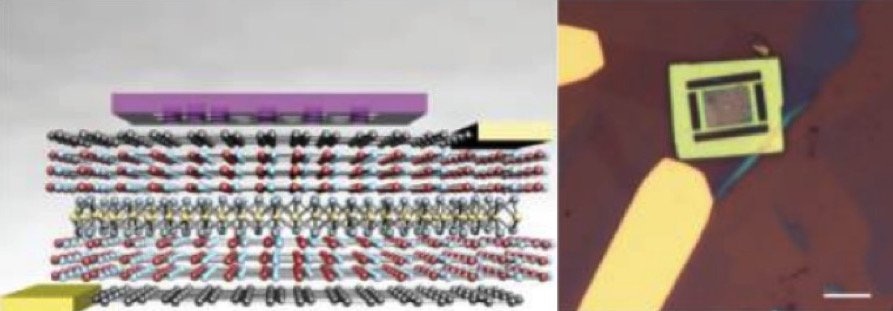Jan 24 2017
 Figure 1: Schematic of the 2D material heterostructure on top of which the photonic crystal cavity is transferred. Figure 2: Optical microscope image of the cavity transferred on the 2D material heterostructure. Credit: University of Washington
Figure 1: Schematic of the 2D material heterostructure on top of which the photonic crystal cavity is transferred. Figure 2: Optical microscope image of the cavity transferred on the 2D material heterostructure. Credit: University of Washington
When an individual searches Google or uses Facebook, the information processing takes place in a large data center. The performance of these data centers can be improved with short distance optical interconnects.
Existing systems utilize electrons that could cause overheating and waste power. However, the utilization of light to transfer data between computer chips and boards can enhance efficiency.
University of Washington Assistant Professor of Electrical Engineering and Physics Arka Majumdar, Assistant Professor of Materials Science and Engineering and Physics Xiaodong Xu and their collaborators have discovered a significant first step towards developing electrically pumped nano-lasers or light-based sources. These lasers are vital for the development of incorporated photonic-based short-distance optical interconnects and sensors.
The study findings were published in a latest edition of Nano Letters.
The researchers demonstrated this first stage through cavity-enhanced electroluminescence from atomically thin monolayer materials. The material’s thinness yields efficient harmonization between the two key laser components. Both the material and cavity-enhanced electroluminescence will allow energy-efficient data centers as well as support high-performance parallel computing.
The recently identified atomically thin semiconductors have demonstrated light emissions in the 2D limit and have created significant interest. However, due to material’s extreme thinness, its emission intensity is not strong enough, and so it is important to incorporate them with photonic devices (nano-lasers) to get more light out.
Researchers have demonstrated electroluminescence in this material [atomically thin monolayer]. Last year, we also reported the operation of an ultra-low threshold optically pumped laser, using this material integrated with nano-cavity. But for practical applications, electrically driven devices are required. Using this, one can power the devices using electrical current. For example, you power your laser pointer using an electrical battery.
Arka Majumdar, Professor, University of Washington
Recently, Majumdar and Xu reported cavity-enhanced electroluminescence in atomically thin material. In order to enhance the emission, a heterostructure of different monolayer materials is used. The emission is weak and broadband (unidirectional) without the cavity.
A nano-cavity enhances the emission and allows single-mode (directed) operation. This enables direct modulation of the emission, a fundamental requirement for the data-communication.
Currently, these structures are of scientific interest and they are considered the latest “gold rush” of condensed matter physics and materials science. Their recent result and the previous display of optically pumped lasers show the potential of electrically pumped nano-lasers, which represent the next milestone for this research. The next achievement will enhance efficiency of data center for optimal performance.
Our team is currently exploring integration of the monolayer materials with a silicon nitride platform. Through this work, we hope to achieve the coveted CMOS [complementary metal-oxide-semiconductor] compatibility, which is the same process by which the computer processors are fabricated today.
Arka Majumdar, Professor, University of Washington
The research is supported by grants from the National Science Foundation and the Air Force Office of Scientific Research.